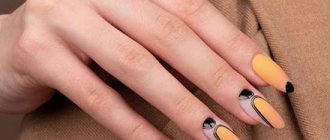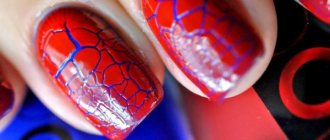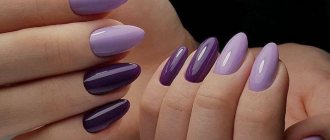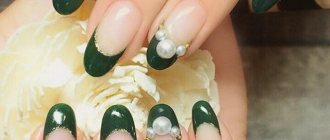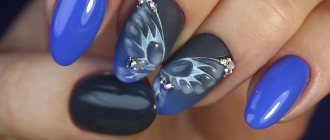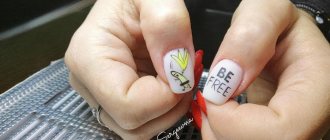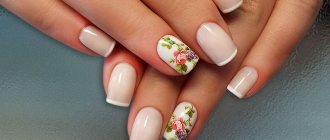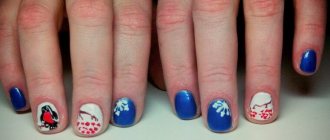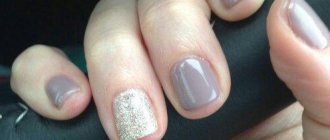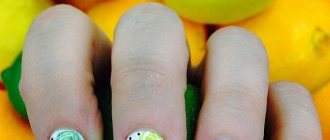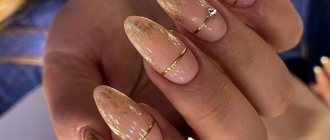Some scientists consider it the most useless part of the human body and suggest that they will disappear in the process of evolution. What will happen instead of a traditional nail plate? Soft pads or another shape? It’s not clear, but before that happens, let’s talk about interesting facts about nails. Many of them are obvious, but a wide range of users are not aware of them.
Who's faster?
The formation of the plate begins in the womb - from about the third week of pregnancy. And pregnant women themselves have a manicure that grows back faster than others, which is facilitated by hormonal changes in the body. During the menstrual cycle it’s the same story, but during breastfeeding the process slows down.
Nails grow an average of 1 mm per week. Whether it will go faster or slower depends on genetic factors, nutrition, and health problems. In 4 months, the nail plate is completely renewed. An interesting fact: there are doctors who determine the rate of recovery of the body after a protracted illness by the intensity of its renewal. If the patient recovers, it grows faster.
Proofreaders, screenwriters, writers, journalists and other professionals whose work involves typing, as well as pianists, can boast of a fast process. Regular percussive movements performed by the fingertips stimulate blood flow and massage the upper area of the fingers. This is the reason for accelerated regeneration.
Rhythmic movements are beneficial and harmful, because regular contact with the hard surface of the keyboard often results in delamination of the plate, fragility, and breakage.
With frequent, prolonged contact of fingers with water, it thickens due to the fact that it has the ability to absorb water. This statement is controversial - some scientists claim that water weakens nails.
But no one disputes the fact that the length of the fingers affects the growth rate: the longer the fingers, the faster the process goes. It slows down with age.
Lovers of beautiful manicures need to sleep more, because during sleep the nail grows longer. The fastest is the middle finger, followed by the ring and index fingers, and the slowest are the little finger and thumb.
№4
Many people bite their nails as children. But did you know that this is a mental disorder, which, moreover, has its own name - onychophagia. According to WebMD, approximately 50% of children ages 10 to 18 bite their nails. By the age of 30, most people give up this “habit.” However, there are people who bite their nails throughout their lives.
Although nail biting is not a harmful activity (although it is unsanitary), it can still cause a number of health problems. Such problems include the development of skin infections, inflammation of the nail bed, etc.
Red or green?
The first varnish was red. It was invented by Charles Revson in the 30s of the last century. The clients to whom he presented the first collection liked the color. Several years passed, and Revson introduced the fashion for nail polish and lipstick of the same tone, which for a long time became the standard of style and good taste.
Ancient Egypt also preferred dark shades. The status of a person was judged by their saturation: the higher he was, the darker the varnish. The upper class used green paint, and Cleopatra preferred terracotta.
By the way, the Egyptians were the first to start doing manicures. In the 60s, archaeologists carried out excavations on the territory of the ancient state, during which they discovered tombs. The mummies in them, as it turned out later, belonged to the keepers of pharaonic nails - that’s what manicure and pedicure masters were called at that time.
Everything you didn't know about manicure
Today, manicure is such a familiar procedure for each of us that no one even thinks about how it was before. But the history of nail care, like any beauty procedure, goes back centuries. Today we decided to introduce you to the most interesting facts from the history of manicure.
Manicure has been around for many years. Archaeologists have even found manicure sets that were used in 3200 BC. There are reliable facts that the pharaohs of Ancient Egypt did manicures and pedicures, and for this they had special people at court.
Modern manicure was “born” in 1917. Dr. G. Coronu was the first to come up with a liquid that allows you to remove cuticles.
The first nail salon opened in 1918.
The first nail polish was created in 1932 by Charles Lashman and brothers Joseph and Charles Revzan . It was bright red. Before this, nails were painted with vegetable dyes: gelatin, henna, wax, and so on.
In Ancient Egypt and Rome, one could determine to which class a person belonged by the color of their nails. Only members of the royal family wore bright colors, but slaves wore pastel shades. Also, the length of the nails indicated the position in society: the longer, the higher the class.
Cleopatra painted her nails with henna, which gave them a brownish-red hue.
And the longest nails in the history of mankind belonged to... a man named Nelvin Feisel Booze . He didn’t cut his nails for over 25 years, and they eventually reached a length of 9 m 53 cm!
But in Russia there was a superstition that you could cut your nails only on Thursdays.
In Ancient China , long nails could be safely worn not only by women, but also by men. Women thus showed others that they belonged to a high class and never engaged in manual labor. But for men it was a symbol of masculinity. Gold and silver were chosen for coloring nails, and since the Ming - red and black.
The ancient Egyptians were also a strange people and for some reason they believed that long nails facilitated communication between mere mortals and the gods; in addition, they were considered a symbol of wisdom. Only people of high position were allowed to grow nails, and slaves were forbidden.
In the 17th century in France, men grew nails only on their little fingers, since court etiquette required not to knock on the door, but to scratch with this long nail.
But in the East , ancient people simply injected vegetable dye directly into the base of the nail. So, the nails grew back already painted.
Manicure was banned in Europe during the Inquisition. People say that this is due to the widespread epidemics at that time, because a lot of germs and bacteria collect under the nails.
In the past, people used other people's nail clippings, pieces of rice paper, silver tips, and even film to lengthen nails. In 1935, a more modern method appeared - they glued linen paper and secured it with varnish. This technology was used until the late 1980s.
But acrylic nail extensions appeared in 1960. There are several versions of its origin. According to the first, this idea came to the mind of an American dentist when he was injured and a broken nail made his work very difficult. According to the second, this same dentist wanted to wean his girlfriend from the stupid habit of biting her nails.
The first “orange stick” for manicure, so familiar today, appeared in 1830.
In 1976, Orly invented the French manicure. Their main task was to come up with a manicure that would go with any outfit. Now we can safely say that the idea was a success!
Read also
Donald Trump was impeached
He is uncomfortable alone: an astrologer about the personal life of Yegor Creed
In honor of Botswana's currency: Meghan Markle and Prince Harry declassified the name of their dog
Signs of the ancients
Not only interesting facts, but also signs are associated with fingers. In Rus', newborns did not have their overgrown nails cut off until they were one year old, in order to protect the child from becoming a thief. Mothers gnawed them and collected them in a special bag, and after the first birthday they buried them under a tree. It was believed that this way they protect the baby from the machinations of evil spirits.
A manicure could tell a lot about its owner in ancient China. The length of the manicure determined the connection of its owner with higher powers: the longer, the stronger.
Long, inwardly curved nails are a national feature of the indigenous Aleuts. Residents of the Aleutian Islands were engaged in a traditional craft - weaving baskets. The length helped women with this, but after 3-4 years of hard manual labor, the fingers became severely deformed and took on a strange appearance and shape.
Nail care is needed almost constantly
People who want their nails to always be attractive are well aware that they need to be looked after, for example, trimmed, almost constantly. At the same time, those for whom this is not so critical are sure that this is not necessary. But the former are more correct, since nails grow at a rate of about 0.1 mm per 24 hours, which is actually not as slow as it might seem at first glance.
Celebrity Quirks
Pushkin also let go of the long nail on his index finger. On top he wore a gold thimble, indicating his affiliation with the Freemasons.
Nikolai Nekrasov, on the contrary, was wary of men with such a manicure. Despite all the passion of an avid gambler, the writer never played with them - he was afraid that the owner of a luxurious manicure would quietly mark the cards.
Record holder
Continuing the topic, we need to remember interesting facts related to records. In 2011, 45-year-old Chris Walton was included in the Guinness Book of Fame. She specially grew her manicure to become a record holder. Its total length on the left hand is 309 cm, on the right - 292 cm.
Walton takes care of his hands on his own, devoting several hours to it every day. To cover such an area with varnish, she needs to use 5 bottles at a time. The record holder says that a giant manicure does not prevent her from playing the piano, driving a car, or doing other things.
Nelvin Faisel Vuz's result is even more impressive. The man has not cut his nails for a quarter of a century and has grown them to 953 cm. He is listed in the Guinness Book of Records - no one has surpassed his result yet.
WHAT DID YOU NOT KNOW ABOUT MANICURE POLISH?
- The invention that pushed the beauty industry, which was just emerging at the beginning of the 20th century, to create nail polishes was car paint.
- The first colored varnish, closest in release form and composition to modern ones, was red. It appeared in the early 1930s.
- The polish had a waterproof formula that allowed the product to stay on the nails for about three days. By the way, before this, the durability of colored manicure was even less: the coating was only enough for one day, and it was washed off with water - it was enough to hold your hands under the tap or put them in the bath.
- As for the safety of varnishes, even today not all of them are perfect. To be 100% sure that your nail polish will not harm your nails, look for bottles marked 5-free: this indicates that the composition does not contain toluene, phthalates, camphor, formaldehyde or formaldehyde resin.
For the sake of science
The review began with the hypothesis about the uselessness of nails, and ends with their benefits for science. They can be used to evaluate the hardness of minerals:
- Grades 7-9 will only scratch a diamond;
- Strength class 6 can be damaged by a file;
- 5th – gives in to a knife;
- on class 1-2 minerals, marks will be left by a human fingernail.
Using the latter, you can calculate the speed of continental drift. It is approximately equal to the growth rate of nails - a small error cannot be excluded.
